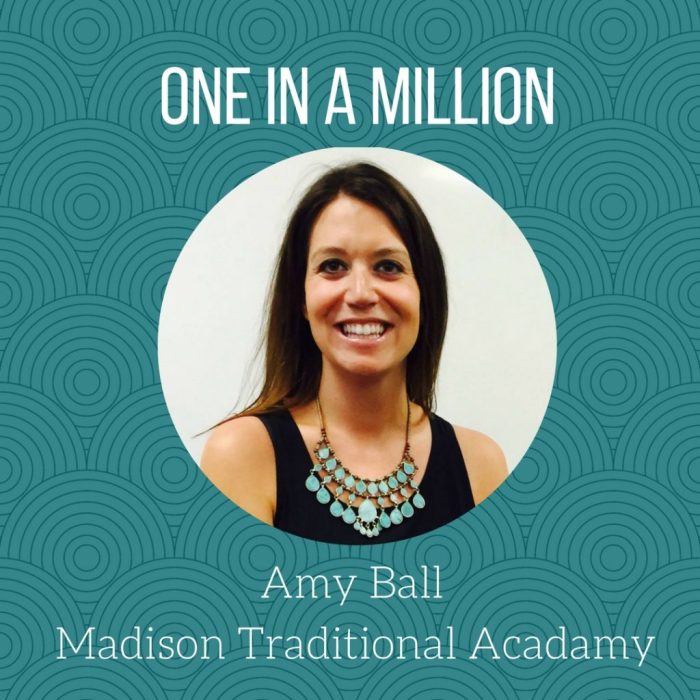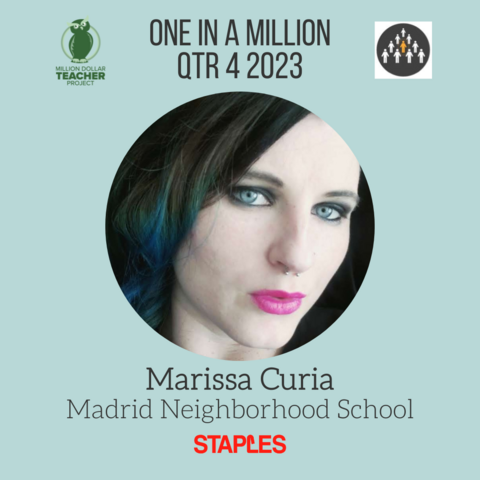How long have you been a teacher?
I moved to Arizona just a few days after graduating from the Lee Honors College at Western Michigan University, and immediately began my education career. I’m currently in my 12th year in the profession, the entirety of which has been spent teaching in a kindergarten classroom.
What made you get into the teaching profession?
When I was in high school, I aspired to study theatre in college and become an actress. Plans changed drastically, however, during my senior year of high school, at which time I joined my school’s cadet program, working daily in the very same kindergarten classroom I learned and played in 12 years prior. I was blessed to work alongside Sheryl Blanchard, my own beloved kindergarten teacher, and watch the magic of inspired teaching and learning unfold before my eyes, and I quickly fell in love with that age group.
Who was your most inspirational teacher and why?
My high school band director, Frank Youngman, had the greatest impact on me growing up. He saw the best in me, saw my potential, and treated me with an incredible amount of respect. He gave me responsibility in his class, shaping me into a young leader and teaching me skills I have used ever since. His relationship with his students after they’ve left his class is something I strive to obtain – he is a good friend to so many, stays connected in their lives, and loves them wholeheartedly. I consider it a gift whenever I get to see him. If I have that same friendship with any of my students when they’re adults, I will consider myself incredibly lucky.
What do you think are some of the biggest challenges teachers in Arizona face right now?
Each year, teachers are required to do more with less and make it look like nothing’s wrong. I learned this firsthand my second year of teaching, when the district I was working in at the time was taken into receivership by the State. An attorney stood before us and said, in a nutshell, “Forget about having pencils, crayons, and paper provided in your classrooms.” Having no money for supplies, and working in an area with very low-income families was an incredible challenge, but my colleagues and I made it work. Not only that, we made it seem as if nothing was different to our students, but the stress was unreal. That same pressure to effectively teach while resources and support decline and expectations and limitations increase, is a huge part of why I believe teachers are leaving today.
I use my voice at Governing Board meetings and when working with district leaders because I know that teacher working conditions are student learning conditions. Montserrat Gomendio, deputy director of the Directorate for Education and Skills at the Organization for Economic Cooperation and Development agrees that, “ensuring high quality teachers, who are satisfied with their jobs, and work in stimulating and supportive environments, must be a priority of all education systems.”
How do these issues affect your day to day?
I’m dedicated to helping improve the working conditions for teachers and the learning conditions for students because I believe in public education, so I spend a lot of my time working with district leaders, which keeps me in meetings after school several days a week. I am proud to advocate for my profession, but that requires a time commitment. Moreover, because Arizona teachers are the lowest paid in our country, I am dependent on the money I make tutoring students in my second job to make ends meet, and that combined with the extra responsibilities I take on with the teachers’ association gets me home during the week between 6:30 – 8pm. I love my job and am proud to be in the teaching profession, but it is an exhausting labor of love.
What does the $250 tax deduction for school supplies for teachers mean to you?
Arizona’s government made huge cuts to public education funding 10-years ago and we are currently working at $1.1 billion below 2008 levels. Arizona currently ranks 51st in teacher salaries across the United States. The reason teachers buy school supplies even though they’re the lowest paid in the nation is because they care about their kids. Teachers should not have to buy their own classroom supplies when they’re at the bottom of the ranking in terms of pay. Arizona’s students deserve to have a full-time, certified teacher in the classroom, and those teachers deserve fair pay. There’s a teacher shortage crisis in Arizona, and we are waiting to hear what the plan from our governor is to fix this.
How are the expectations of becoming a teacher different than the reality?
A college or university simply cannot prepare you for all of the extra things that are expected of a teacher.
In addition to being an educator, teachers are also:
Tech experts, spare-pen providers, cheerleaders, parental reminders, travel planners, bankers, budget-cut supply providers, disciplinarians, drill sergeants, entertainers, room custodians, activists, advice givers, abuse detectives, secretaries, dieticians, part-time parents, nose wipers, mentors, referees, confidantes, social workers, nurses, therapists, tutors, psychologists, and drug detectors.
The list goes on and on.
Why do you think teachers burn out so quickly?
Teaching is hard, physically and mentally demanding, and it is difficult to find a work-life balance. Speaking as an early childhood educator, I can honestly say that there is not one moment that my students are in my classroom during which I’m not making a hundred decisions all at one time. It hurts my head trying to even sort out everything I do simultaneously, but here’s an example:
As I’m reading a story to the class, I am not only reading the words aloud and showing the illustrations, I’m also keeping my eye on all 26 of my 5 & 6-year old students to make sure they’re engaged. There could be a child who looks sleepy because they stayed up too late with visiting relatives the night before, a student who looks sad because they split their time between their mom and dad and haven’t seen one of their parents for almost a week. There are students who are “frienemies” and I have to keep them separated yet they are drawn to each other like magnets. I have to make sure I’m engaging all of these children and giving them what they need, all while reading the book to a whole group. I have to think about their attention spans, plan the next activity in my head when this one isn’t even finished, keep my eye on the clock to ensure we’re on schedule, and make sure everyone is staying in their own space, attentive, and engaged. I have to ask questions that relate to the text and draw on prior knowledge, and tie this picture book to some aspect of our math/science/social studies curriculum. At the same time, I need to get up, while still reading so I don’t lose attention of the other 25 kids in my class, and clean and bandage a wound, tie a shoelace, comfort a crying student, and mentally draft email responses to the parents who have contacted me regarding their individual students. I’m missing a ton of things that literally happen during a single instance like this, but the point is clear: there’s not even one moment of downtime in a classroom.
So, take that information, and then also consider that expectations increase while support and resources decrease. Throw in the fact that teachers are not appropriately compensated for the work they do and the degrees they have earned, and then place everything in the setting of a state that ranks 51st in the nation for teacher salaries, requiring teachers to have 2nd and 3rd jobs – not to buy boats, but to pay their bills and support their families.
Great leaders can do amazing things on behalf of students, even against the greatest of odds. Arizona teachers dedicate their lives to achieving the dream of providing a level playing field for each and every child in our class. It’s what gets us out of bed every morning, drives us through each day, and what keeps us awake at night.
What “fills your cup” when you’re running on empty?
The same expectation I have of my students, to be their best every day, I have for myself. I expect myself to be better and do better each day. But there are times when all the expectations and responsibilities build up and it feels overwhelming. Just last week, I was feeling super stressed, worried, and overwhelmed. As I was supervising my students at recess, I found myself fighting back tears because I was truly running on empty. At just that moment, one of my little girls came running up to me and said, “Miss Ball, do you want to watch me spin?” and she joined a friend as they galloped and spinned and frolicked and look absolutely like carefree little bundles of vulnerable and innocent love. And it was just the thing I needed, being reminded of how important my job is, and what am impact I make on so many tiny human beings each day. Students deserve an excited adult who is looking for those magic moments. That fills my cup.
What are some of the most thoughtful and effective ways parents and the community can show gratitude?
Voting for legislators and state leaders who truly value public education by increasing funding for Arizona students. It is essential to recognize the critically hard, important work educators across our State are doing daily to support and raise expectations for our children, and lift up the teaching profession by recognizing that teachers need better preparation, better support, and more resources to do their exceedingly important job. In 1848, Horace Mann, pioneering American educator, stated that “education then, beyond all other devices of human origin, is a great equalizer of the conditions of men — the balance wheel of the social machinery.” This still rings true today, and I believe that when we empower teachers and give them freedom and flexibility to drive real change in all students’ lives, our schools can then fulfill their fundamental destiny to be gateways to opportunity.
What is your wish for Arizona’s children?
More than 50 years ago, President Lyndon Johnson called on Congress to establish “full educational opportunity as our first national goal.” Johnson signed the Elementary and Secondary Education Act of 1965 because he believed that we “could never rest while the door to knowledge remained closed to any American.” I share Johnson’s thoughts and fervently believe that every student, in every district, and in every state, has the right to an excellent education. Every single child is important.
Every child in AZ deserves the attention and focus of a full-time, certified teacher who recognizes their unique strengths and challenges, in order to reach their full potential. My focus is on a student growing, rather than all children reaching a set benchmark, and by doing that I am honoring and respecting that student as a capable, independent, and important being. I set my sights on fostering a community in which the students are proud of helping their classmates. This influences their behavior in and out of the classroom because they have the love and support from one another that is needed in order to feel safe to “take chances, make mistakes, and get messy,” as my teacher idol, Miss Frizzle from The Magic Schoolbus likes to say. I love to see my students embrace the different abilities of their classmates, understanding that differences are not only okay but important, and that is why I strive to build a safe harbor where my students want all to succeed. My goal is for my students to embrace the attitude that their neighbor’s growth is just as important as their own.








